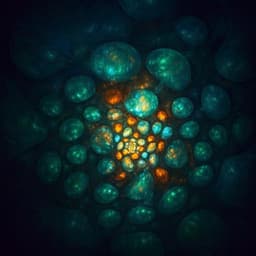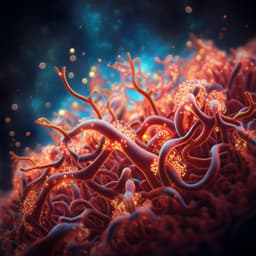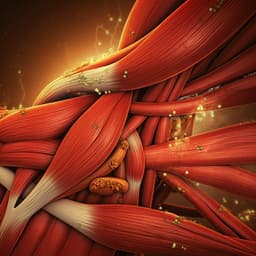
Medicine and Health
S1PR1 induces metabolic reprogramming of ceramide in vascular endothelial cells, affecting hepatocellular carcinoma angiogenesis and progression
X. Wang, Z. Qiu, et al.
Explore the groundbreaking findings of Xuehong Wang and colleagues as they unveil the pivotal role of S1PR1 in angiogenesis and the progression of hepatocellular carcinoma (HCC). This research reveals how S1PR1's regulation can be a key therapeutic target, offering hope in the fight against HCC. Discover the exciting mechanisms that put S1PR1 at the forefront of new cancer therapies.
~3 min • Beginner • English
Introduction
Hepatocellular carcinoma (HCC) is highly aggressive with poor prognosis and is characterized by abundant vasculature that supports metastasis, making antiangiogenic therapy attractive. Current antiangiogenic drugs (e.g., sorafenib) show benefits but are limited by adverse events and resistance, necessitating discovery of new angiogenic regulators. Tumor angiogenesis is driven by tumor microenvironment cues (cytokines, inflammatory factors) that reprogram endothelial cells (ECs) into HCC-associated ECs (HAECs) to enhance proliferation, migration, and tube formation. Metabolic reprogramming of ECs, encompassing glycolysis, fatty acid oxidation, and glutamine metabolism, contributes to angiogenesis; however, the impact of sphingolipid metabolic reprogramming in vascular ECs on tumor angiogenesis is poorly defined. Ceramide lies at the center of sphingolipid metabolism, with multiple synthetic pathways and derivatives including sphingosine-1-phosphate (S1P), which promotes angiogenesis via S1PR1–5. S1PR1 is abundant in ECs and has been implicated in tumor angiogenesis, but its role and mechanisms in HCC angiogenesis are unclear. Ceramide synthases (CerS1–6) generate ceramides with distinct acyl chain lengths, influencing physiological and pathological processes. While synthetic ceramides (e.g., C2-ceramide) can inhibit angiogenesis, the role of endogenous ceramides in mammalian angiogenesis remains unclear. This study investigates S1PR1 in HCC vascular ECs and delineates mechanisms involving ceramide metabolism, demonstrating that S1PR1 upregulation in ECs promotes angiogenesis and HCC progression by downregulating CerS3 (via S1PR1-driven CerS6 nuclear translocation), reducing ceramide and PTEN, thereby activating AKT/ERK signaling. The study also explores pharmacologic targeting of S1PR1, including with Lenvatinib.
Literature Review
Methodology
Human specimens: Formalin-fixed paraffin-embedded and frozen HCC tissues with paired peritumoral liver were analyzed for S1PR1 and endothelial marker CD31 by immunohistochemistry (IHC) and immunofluorescence (IF). A tissue microarray comprising 150 paired HCC and adjacent nontumorous liver tissues was used to quantify S1PR1 expression and assess association with clinical stage.
Cell culture and generation of HAECs: Endothelial cells (EA.HY926 and HUVECs) were treated with conditioned media from HCC cell lines (Huh7, SK-Hep1) for 48 h to induce HAECs. EC identity and activation were validated by increased CD31/CD34/CD105 expression.
Genetic and pharmacologic manipulations: S1PR1 was overexpressed using plasmids or silenced by siRNA/shRNA in ECs. Proangiogenic stimuli used included S1P (40 µM), IL-6 (25 ng/mL), and VEGFA (80 ng/mL). STAT3 Y705 phosphorylation was inhibited with stattic (2 µM). S1P levels in HCC conditioned media were modulated by overexpressing or knocking down sphingosine-1-phosphate lyase (SGPL1) in SK-Hep1 or Huh7 cells, respectively. The S1PR1 antagonist W146 (20 µM) was used to block S1PR1. Lenvatinib was tested across 0–40 nM for effects on S1PR1 and EC function. Ceramide synthesis was inhibited with fumonisin B1 (FB1) in vitro and in vivo.
Assays: Proliferation was measured by CCK-8. Migration and invasion were assessed by transwell assays. Tube formation was evaluated by seeding ECs (90×10^3 cells/well) on Matrigel-coated 24-well plates in serum-free DMEM and quantifying network polygonal areas after 6 h at ×20 magnification. Protein expression and phosphorylation (S1PR1, STAT3/STAT1, CerS3/6, SPHK1/2, SGPL1, AKT, ERK1/2, PTEN) were analyzed by Western blot. mRNA levels were measured by real-time PCR. A targeted PCR array profiled 38 sphingolipid pathway genes. S1P content was quantified by ELISA. Ceramide levels were assessed by IF. Nuclear/cytoplasmic fractionation and IF examined CerS6 localization. Luciferase reporter assays in HEK-293T cells tested CerS6 effects on the CerS3 promoter; cells were cotransfected with CerS3 promoter-luciferase, CerS6 plasmid, PRL-TK control, and where indicated siS1PR1. Proximity ligation assay (PLA) was used to detect ceramide–PTEN interactions.
Co-culture and crosstalk studies: HCC cells (Huh7, SK-Hep1) were co-cultured with ECs (control or S1PR1-silenced) to assess effects on HCC cell proliferation, migration, and invasion.
Animal models: Male BALB/c-nu nude mice (4 weeks old) were used under approved protocols. For subcutaneous xenografts, Huh7 cells (5×10^6) alone or mixed with ECs (2.5×10^6; EC-NC or EC-shS1PR1) at a 2:1 ratio were injected into the flank in Matrigel. Tumor growth was measured every 2–3 days; volume = 0.5 × longest × shortest^2. For ceramide inhibition, FB1 (0.4 mg/kg, 0.24 mL/mouse) was administered when xenografts reached ~50 mm^3, and in another experiment from day 16 to 30 post-injection in cohorts initiated with Huh7 + EC-NC or Huh7 + EC-shS1PR1 (cell doses per figure). At study end, tumors were harvested for IHC (CD31, S1PR1) and analyses.
Statistics: Data are mean ± SD. Paired Student’s t test compared HCC vs peritumoral tissues. One-way ANOVA assessed group differences. P < 0.05 was considered significant.
Key Findings
- S1PR1 is selectively upregulated in vascular ECs (CD31+ cells) of HCC tissues compared with peritumoral liver endothelium; tissue microarray analysis across 150 paired samples showed significantly higher S1PR1 IHC scores in tumors (P < 0.01). Higher vascular S1PR1 correlated with advanced HCC stage (P < 0.05).
- Conditioned media from HCC cells (Huh7, SK-Hep1) converted ECs into HAECs with increased EC markers and elevated S1PR1, enhancing proliferation, migration, and tube formation; similar effects were confirmed in HUVECs.
- S1PR1 gain-of-function increased, and loss-of-function decreased, EC migration and tube formation. In co-culture, EC S1PR1 knockdown reduced Huh7 and SK-Hep1 proliferation, migration, and invasion.
- In vivo, Huh7 + EC-NC xenografts formed larger tumors and had higher vessel density than Huh7 alone or Huh7 + EC-shS1PR1; EC S1PR1 depletion reduced angiogenesis in tumors.
- Mechanism of S1PR1 upregulation: S1P (40 µM), IL-6 (25 ng/mL), and VEGFA (80 ng/mL) increased STAT3 Y705 phosphorylation and S1PR1 expression in ECs; HAECs displayed elevated p-STAT3 but not p-STAT1. Stattic (2 µM) blocked S1P/IL-6/VEGFA-induced S1PR1 expression. Manipulating SGPL1 in HCC cells altered S1P in conditioned media and correspondingly modulated S1PR1 expression and angiogenic behavior in ECs.
- Sphingolipid pathway reprogramming: PCR array revealed a marked 74-fold decrease in CerS3 mRNA in HAECs; CerS3 protein was reduced, while CerS6 protein was unchanged in total lysates. Ceramide levels were significantly decreased in HAECs. S1PR1 knockdown restored CerS3 and ceramide levels and reduced tube formation.
- S1P pathway enzymes SPHK1 and SGPL1 were downregulated in HAECs; SPHK2 unchanged. S1P content was decreased in HAECs, indicating that enhanced angiogenesis was not driven by S1P levels.
- Ceramide signaling: HAECs exhibited increased AKT and ERK1/2 phosphorylation and decreased PTEN. S1PR1 knockdown or CerS3 overexpression increased PTEN and suppressed AKT/ERK1/2 activation. PLA indicated increased ceramide–PTEN interaction upon S1PR1 knockdown, linking higher ceramide to PTEN activation and AKT/ERK inhibition.
- Transcriptional control: CerS6 showed increased nuclear localization in HAECs and reduced nuclear localization when S1PR1 was knocked down, indicating S1PR1-dependent CerS6 nuclear translocation. CerS6 overexpression decreased CerS3 promoter activity (~2-fold). S1PR1 knockdown increased CerS3 promoter activity and partially rescued CerS6-mediated repression.
- Pharmacologic targeting: W146 (20 µM) inhibited S1PR1 upregulation and attenuated EC migration and tube formation induced by HCC conditioned media. Lenvatinib at >10 nM reduced S1PR1 expression dose-dependently; at 40 nM it synergized with S1PR1 knockdown to further suppress EC migration and tube formation.
- In vivo ceramide modulation: FB1 treatment promoted xenograft growth irrespective of EC S1PR1 status, while EC S1PR1 knockdown mitigated FB1-driven tumor promotion. In vitro, FB1 reduced EC ceramide and decreased tube formation.
Discussion
This study identifies endothelial S1PR1 as a central driver of HCC angiogenesis and progression. In HCC tissues, S1PR1 is enriched in tumor vasculature and associates with advanced stage, implying clinical relevance. Functionally, S1PR1 enhances EC angiogenic behaviors in vitro and supports tumor growth and vascularization in vivo; its knockdown suppresses these phenotypes and impairs the pro-tumor influence of ECs on HCC cells. Mechanistically, tumor-derived factors S1P, IL-6, and VEGFA converge on STAT3 Y705 phosphorylation to induce S1PR1 in ECs. Beyond receptor upregulation, S1PR1 rewires sphingolipid metabolism by inducing CerS6 nuclear translocation, which represses CerS3 transcription, decreasing cellular ceramide. Reduced ceramide weakens ceramide–PTEN interaction, lowers PTEN, and activates AKT/ERK signaling, thereby promoting angiogenesis. Thus, S1PR1 links soluble tumor cues to a metabolic-transcriptional circuit that amplifies proangiogenic signaling. Pharmacologic inhibition of S1PR1 (W146) or downregulation by Lenvatinib suppresses EC angiogenic responses, and Lenvatinib synergizes with S1PR1 knockdown, suggesting therapeutic opportunities. While some prior mouse tumor models reported opposing S1PR1 vascular phenotypes, differences in species, tumor types, and experimental systems may underlie discrepancies; notably, this study includes validation in human HCC tissues. The data support combined targeting of VEGF/VEGFR2 pathways and S1PR1 to improve antiangiogenic efficacy in HCC.
Conclusion
Endothelial S1PR1 is upregulated in HCC vasculature via STAT3 activation by tumor-derived S1P, IL-6, and VEGFA, and drives angiogenesis and tumor progression by reprogramming ceramide metabolism. S1PR1 promotes CerS6 nuclear translocation, transcriptionally represses CerS3, reduces ceramide and PTEN, and activates AKT/ERK signaling. Targeting S1PR1 with agents such as W146 or leveraging Lenvatinib’s capacity to downregulate S1PR1 yields antiangiogenic effects, with combination strategies showing synergy. These findings position S1PR1 as a promising antiangiogenic target and suggest integrating S1PR1 inhibition with current therapies for HCC. Future work should develop selective S1PR1 inhibitors suitable for clinical use, validate biomarkers (vascular S1PR1, ceramide profiles) in patient cohorts, delineate the regulation of CerS6 nuclear trafficking, and assess combinatorial regimens with VEGFR inhibitors or immunotherapy.
Limitations
The study relies primarily on in vitro endothelial and HCC cell line models and subcutaneous xenografts, which may not fully recapitulate human liver tumor microenvironments. Clinical outcome correlations with vascular S1PR1 were not assessed beyond stage association. Discrepancies with prior mouse tumor studies suggest context- and species-dependence. The effects of FB1 differed between in vitro (reduced tube formation) and in vivo (enhanced tumor growth), reflecting complexity of ceramide biology in tissues. While Lenvatinib reduced S1PR1 at higher concentrations, the pharmacodynamic relationship to clinical dosing and on-target specificity for S1PR1 require further clarification. The work did not dissect ceramide species chain-length contributions or fully map upstream signaling controlling CerS6 nuclear translocation.
Related Publications
Explore these studies to deepen your understanding of the subject.







